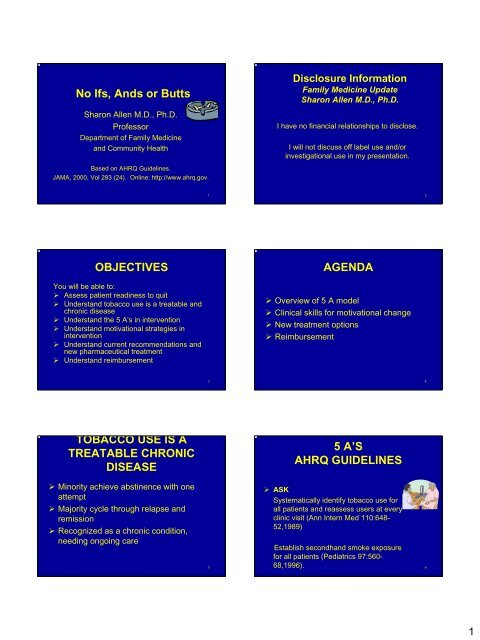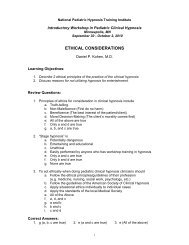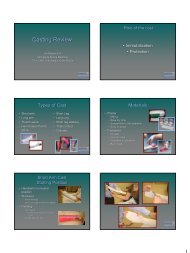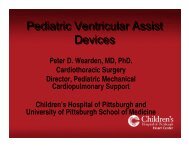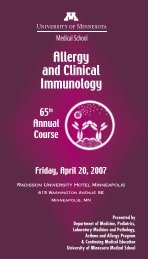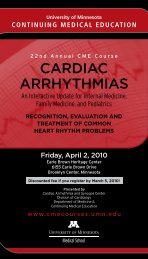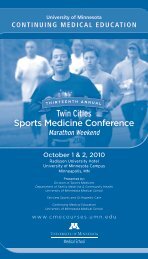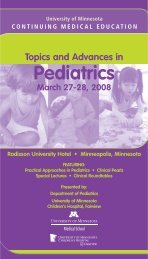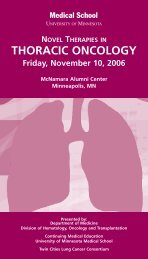No Ifs, Ands or Butts - Continuing Medical Education
No Ifs, Ands or Butts - Continuing Medical Education
No Ifs, Ands or Butts - Continuing Medical Education
Create successful ePaper yourself
Turn your PDF publications into a flip-book with our unique Google optimized e-Paper software.
ASSIST‣ Negotiate quit date‣ Counsel to supp<strong>or</strong>t cessationand build coping skills‣ Discuss pharmacotherapy‣ Offer Help Line: QUITPLAN 1-888-354-PLAN‣ Provide supplementarymaterialsJAMA 259:2883-89; J Gen Intern Med 6:1-8,199113 14Developing a quit plan• Set a quit date• Review past quit attempts• Anticipate challenges• Other smokers in the household• AlcoholReality Check• Connect your patient to FREE programsthat will make it EASIER f<strong>or</strong> them to quit.1516ARRANGERelapse Rate Over Time‣ Relapse prevention- Withdrawal symptoms mostintense first 2-5 daysirritabilityincreased hungerincreased tensioncravinginsomnialack of concentration17% Abstainers10090807060504030201000 1 2 3 4 5 6 7 8 9 10 11 122 weeks Time (Months)HeroinSmokingAlcohol183
RELAPSE PREVENTION• Early follow-up• Lack of supp<strong>or</strong>t• Negative mood• Prolonged withdrawal• Weight gain19ARRANGERecycleRelapse?ASKPrecontemplationActionStageASSISTContemplationPlanningStageADVISEASSESS20MOTIVATIONALINTERVIEWINGMOTIVATIONALINTERVIEWINGI. EXPRESS EMPATHY● Ask/Invite patient to tell about behavi<strong>or</strong>- Listen empathetically- Reflect what you hearII.ASSESS DISCREPANCY● Conviction 1-10● Confidence 1-10● Stage of readiness21III. ROLLING WITH RESISTANCE● Increase confidence- Expl<strong>or</strong>e past experience● Increase conviction- Expl<strong>or</strong>e ambivalence (pros vs. cons)IV. SUPPORT SELF EFFICACY● Build on past successes● Offer range of alternative approachesMiller and Rollnick, 200222Modified Tobacco ProductsWhat pharmacotherapies are available toASSIST in the quit attempt?By using the pharmacotherapiesfound to be effective in the PHSGuideline, you can double <strong>or</strong> tripleyour patients’ chances of abstinence.23244
Nicotine Gum• OTC• Do <strong>No</strong>t Use Within 15 Minutes Of Drinking AnyAcidic Beverage (Coffee, Tea, OJ)• Chew To Release Nicotine• Use As Needed (6-16 pieces/day)• Park In Cheek• <strong>No</strong> Concurrent Nicotine Use• Side Effects May Include Hiccups31 32• Strength– 2mg ~ 1ppd– 4mg ~ 2 – 3 ppd•Flav<strong>or</strong>sNicotine Gum33 34Nicotine Nasal Spray• Prescription Only• Use By Inhaling And Holding Breath• Citric Acid Based F<strong>or</strong>mula• Side Effects May Include Nasal MembraneIrritation• Use As Needed• <strong>No</strong> Concurrent Nicotine Use35 366
Nicotine Inhaler• Prescription Only• Uses Delivery Device With AerosolizedNicotine Cartridge• Use As Needed (6-16 cartridges/day)• Frequent Puffing is Required• <strong>No</strong> Concurrent Nicotine Use37 38Nicotine Lozenge• OTC• 2 <strong>or</strong> 4 mg• Use enough (6-16 lozenges/day)• Do <strong>No</strong>t Use Within 15 Minutes Of Drinking AnyAcidic Beverage (Coffee, Tea, OJ)• Place In Mouth, Allow To Dissolve• <strong>No</strong> Concurrent Nicotine Use• Side Effects May Include Hiccups39 40Bupropion SRBupropion SR• <strong>No</strong>n-nicotine medication approved by theFDA as an aid to smoking cessationtreatment• Available by prescription only• Mechanism of action: presumably blocksneural reuptake of dopamine and/<strong>or</strong>n<strong>or</strong>epinephrine• Also called Zyban <strong>or</strong> Wellbutrin41427
Bupropion SR• Contraindicated if Head Injury <strong>or</strong>Seizure Dis<strong>or</strong>der• MAO Inhibit<strong>or</strong> within previous 2 Weeks• Current Use of Wellbutrin• Hx of An<strong>or</strong>exia Nervosa <strong>or</strong> Bulimia• Can Lower Seizure Threshold• Recommend <strong>No</strong> Concurrent AlcoholUseJ<strong>or</strong>nby et al, 1999; NEJ 340(9), p. 685Bupropion SR• May Be Used In Combination WithNicotine Replacement• Side Effects Include Dry Mouth andHeadache4344Bupropion SR• Dosing:– start 1-2 weeks bef<strong>or</strong>e quit date– 150 mg <strong>or</strong>ally once daily x 3 day– 150 mg <strong>or</strong>ally twice daily x 7-12 weeks– no taper necessary at end of treatmentLong-term Pharmacotherapy• Long-term NRT presents low health risk• Persistent withdrawal symptoms (physicalurges and psychological cravings• FDA approved bupropion SR• Maintenance - efficacious as maintenancemedication f<strong>or</strong> 6 months• Delays weight gain associated withstopping smoking.4546www.askandact.<strong>or</strong>gTable of Meta AnalysesF<strong>or</strong> EfficacyOfCessation Products47Product Auth<strong>or</strong> Follow-upPointNumberof TrialsEfficacyMeasureN. Patch Fi<strong>or</strong>e et al, 1994 6 months 13 O.R. = 3.0(2.4, 3.7)N. Gum Silagy et al, 1994 12monthsN. Inhaler Leischow et al,1996N. Spray Blondal et al,1997N. Lozenge Wallstrom et al,20001 O.R. = 1.6(1.5, 1.8)6 months 1 O.R. = 3.05(1.42, 6.57)6 months 1 R.R. = 1.88(0.88, 3.99)6 months 1 O.R. = 2.42(1.02, 5.85)Bupropion SR J<strong>or</strong>nby et al, 1999 6 months 1 O.R. = 2.3(1.4, 3.7)Bupropion SR +PatchBehavi<strong>or</strong>alCounselingJ<strong>or</strong>nby et al, 1999 6 months 1 O.R. = 2.7(1.7, 4.4)AHRQ 2 months 15 O.R. = 2.7(2.2, 3.2) 488
VareniclineVarenicline: A Highly Selective α4β2 Recept<strong>or</strong>Partial Agonist• Approved by FDA in May, 2006• Marketed as Chantix• A non-nicotine medication• A selective α4β2 NicotinicAcetylcholine Recept<strong>or</strong> Partial Agonist• “Like methadone f<strong>or</strong> smokers”• Black Box f<strong>or</strong> Depression and SuicideRisk49NicotineBinding of nicotine at the α4β2 nicotinic recept<strong>or</strong> inthe Ventral Tegmental Area (VTA) is believed tocause release of dopamine at the Nucleus Accumbens(nAcc)ChantixChantix is an α4β2 nicotinic recept<strong>or</strong> partial agonist, acompound with dual agonist and antagonistactivities. This is believed to result in both a lesseramount of dopamine release from the VTA at thenAcc as well as the prevention of nicotine binding atthe α4β2 recept<strong>or</strong>s50Varenicline Phase 3 Studies: EfficacyMeasurements: CO-Confirmed ContinuousAbstinence Rates Wks 9-52Varenicline: MostCommon Adverse EventsFrom 12-Week Fixed-Dose, Placebo-Controlled Studies5152Rates of DiscontinuationVarenicline – Prescribing Inf<strong>or</strong>mation400350300250200150100500Varenicline Bupropion SR PlaceboRandomizedDiscontinuedAE• Start varenicline one week bef<strong>or</strong>e the quit date f<strong>or</strong>maximum effectiveness• Recommended treatment is 12 weeks:– Days 1-3………..1 pill (0.5 mg) per day– Days 4-7………..1 pill (0.5 mg) twice a day (am & pm)– Day 8-end………1 pill (1 mg) twice a day (am & pm)• An additional course of 12 weeks f<strong>or</strong> maintenance can beconsidered• First Month – starter month pak• Subsequent Months – continuing month pak53549
Nicotine Assisted Reductionwith Intent to Stop• Do not cause significant adverse reactions• Reduces smoke inhalation• Helps reduce cigarette consumption• Increased motivation to stop smokingSo What’s Really New?• Vaccines• Cannabinoid recept<strong>or</strong> 1 blocker(Rimonabant)Source: http://www.treatobacco.net/faq/default.cfm?questionID=16Raw M, McNeil A, West R, Armstrong M, Arnott D, NARS; Guidance f<strong>or</strong>health professionals. London, ASH, 2005.http://www.ash.<strong>or</strong>g.uk/html/cessationdetail.php#reduction55Http://www.treatobacco.net/faq/default.cfm?questionID=18Karl Fagerstrom, PhD, Smokers Inf<strong>or</strong>mation Centre,56Helsingb<strong>or</strong>g, SwedenCounseling• Group programs increase cessation, OR2.04 (95% CL 1.60-2.60)• Individual counseling is effective• Telephone counseling compared to lessintensive intervention increases quit rates,OR 1.56 (95% Cl 1.38-1.77)Efficacy of and estimated rates f<strong>or</strong> interventionsdelivered by different providers (41 studies)Type ofProviderNumber ofarmsEstimated oddsratio (95% CI)Estimatedcessation rate(95% CI)<strong>No</strong> provider 38 1.0 8.2Multipleproviders<strong>No</strong>n-medical(social w<strong>or</strong>ker)14 3.8 (2.6-5.6)23 1.8 (1.5-2.2)25.5 (18.1-32.7)14.1 (12.0-16.3)Physician 36 1.5 (1.2-1.9) 12.0 (9.6-14.3)57<strong>No</strong>n-physician(dentist, nurse)JAMA, 199620 1.4 (1.1-1.8) 11.5 (9.0-14.0)58% of Patients706050403020100How are we doing?Patient's Rep<strong>or</strong>t of Tobacco Treatment at CurrentVisit (n=2581)AskAdviseAssist-MedsF/UReferralWhen your patient wants to quit andyou are double-booked…• ASK about tobacco use.• ADVISE to quit.• ASSESS willingness to make a quit attempt.• Prescribe & REFER596010
So, how can youget paid f<strong>or</strong> your w<strong>or</strong>kon tobacco cessation?Medicare Payment• Effective March 22, 2005, tobaccocessation counseling covered f<strong>or</strong>smokers (8 visits annually with 4sessions per attempt)• Effective January 2006, prescriptiondrug benefit covers treatmentsprescribed by a physician (OTC notcovered)67Source: www.askandact.<strong>or</strong>g 68PaymentHCPCS Billing Codes• Counseling < 3 minutes covered under E &M code• 99406: 3-10 minutes counseling ($13)1/1/08• 99407: >10 minutes counseling ($25) 1/1/08• Use modifier 25 f<strong>or</strong> an appropriate E&Mservice on that same day• Face-to-Face counseling timeSource: www.askandact.<strong>or</strong>g 69http://www.momedicare.com/provider/viewarticle.aspx?pf=yes&articleid=5685Payment• If plans cover counseling use ICD-9 Codes• 305.1 Tobacco Dependence• 292 Nicotine Withdrawal• V15.82: Hist<strong>or</strong>y of Tobacco Use• Provide clinically relevant diagnosis code suchas; cough 786.2 <strong>or</strong> lung cancer 162• Document time spent counselingSource: www.askandact.com70Private InsurersMost insurers provide coverage f<strong>or</strong> at leastone type of pharmacotherapy f<strong>or</strong> tobaccocessation and at least one type ofbehavi<strong>or</strong>al intervention.Source: www.askandact.<strong>or</strong>g71Private Insurers• Use billing codes in the categ<strong>or</strong>ies of:• Preventive Medicine Treatments• Tobacco Dependence Treatment aspart of the initial <strong>or</strong> periodiccomprehensive preventive medicineexam• Tobacco Dependence Treatment asspecific counseling and/<strong>or</strong> risk fact<strong>or</strong>reduction72www.askandact.<strong>or</strong>g12
MedicaidThirty-seven states now coverone <strong>or</strong> m<strong>or</strong>e treatment f<strong>or</strong>tobacco dependenceWRAP-UP‣ Tobacco use is a chronic disease‣ Methods of intervention:-5 A’s- Motivational interviewing- Treatment modalities:pharmacological and counseling‣ Quitting is a processwww.askandact.<strong>or</strong>g7374Video of Frank Cerra75 76RESPONSES TO PATIENTS’ REASONS TO USE TOBACCO, CONTINUED“Helping Tobacco Users Quit: Tobacco Cessation Training f<strong>or</strong> Health Care Professionals” CD Rom created by Myra A77 78Crawf<strong>or</strong>d, PhD, MPH & Lesa L. Woodby, PhD, MPH, Department of Family & Community Medicine, University ofAlabama at Birmingham13
SMOKELESS TOBACCO• Higher prevalence in young males• Abs<strong>or</strong>ptions depends on pH of buccalmucosa• Snuff and chewing tobacco• Graded levels of nicotine• Addictive• Associated with <strong>or</strong>al cancers leukoplakiaand gingivial disease79 80Smokeless TobaccoCIGARS• Varying levels of nicotine• Large cigars nicotine abs<strong>or</strong>bed through<strong>or</strong>al mucosa• Smaller cigars inhaled818214


